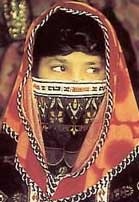|
Photo source:
Peoples of Eritrea/ Francescana Printing Press  |
According to statistics from 2000, nearly seventeen million Hijazi Arabs lived in Saudi Arabia. No doubt that number has increased since then and with less than one percent of the Hijazi having accepted Christ, this people group has a great need to hear the gospel. The Hijazi Arab are more commonly known as the Saudi Arab and live predominantly along the Red Sea coast and in urban centers. The Hijazi, who make up the majority of the Saudi Arabian population, speak Hijazi Arabic (also known as Arabiya).
More than half of Saudi Arabia is desert and because of the hot climate, the Saudi Arabs dress in lightweight, light-colored, loose-fitting clothing. Scattered throughout the desert plains are fertile oases where towns and villages are often located. Although Saudi Arabia has become self-sufficient in producing many dairy and poultry products, the lack of water has made only less than one percent of the land useful for farming.
Traditionally, farming and raising livestock have been the staple economic activities; however, since the development of the oil industry, the government has placed a high emphasis on improving roads, airports, seaports and the power industry. Today the government is the largest employer in Saudi Arabia, with over thirty-four percent of the population holding civic-related jobs.
Due in part to the economic boost from the oil industry, literacy rates have increased from three percent in the early 1960s to sixty-two percent today. Teacher training institutes have also been established to reduce the country’s dependence on other Arab countries for teachers.
Although nearly all Hijazi Arabs are Muslim, they represent many Islamic sects. Since the mid-1700s when Mohammed ibn Adb al-Wahhab formed a fundamentalist sect, many Saudis have seen themselves as the holders of the true Islamic faith. Mecca, the holy city where many Muslims make an annual pilgrimage, is located near the coast of the Red Sea.
Sharing the gospel with the Saudi Arabs is not only challenging to the Christian, it is also costly to the convert—new believers may lose their families, jobs or even their lives. With very few mission organizations working in this area, John 4:35 becomes even more important: “Do you not say, 'There are yet four months, and then comes the harvest?' Behold, I say to you, lift up your eyes and look on the fields, that they are white for harvest.”
For information on the Hijazi of Saudi Arabia, visit:
Bethany World Center's KeepSafe Unreached Peoples Prayer Profile on the Hijazi.
PeopleTeams.org and click on specific region of the world (North Africa and Middle East to learn more about ministries in Saudi Arabia)
(Information compiled from Joshua Project.)
(Note: The website links above are intended to provide you with more information about this people group. Some of the links are to groups that are not religious in nature but who provide information and background that may be helpful in researching this people group. The content of each of the websites linked to is the sole responsibility of the linked-to organization. Views expressed on these websites do not necessarily reflect the opinions and beliefs of the staff or writers of Lausanne World Pulse or those of the Lausanne Committee for World Evangelization, Institute of Strategic Evangelism, Evangelism and Missions Information Service or Intercultural Studies Department.)

